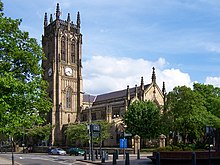Robert Dennis Chantrell (14 January 1793 – 4 January 1872) was an English church architect, best-known today for designing Leeds Parish Church, now Leeds Minster.
Robert Dennis Chantrell
| |
|---|---|

| |
| Born | (1793-01-14)14 January 1793 |
| Died | 4 January 1872(1872-01-04) (aged 78)
Norwood, London
|
| Nationality | English |
| Occupation | Architect |
| Buildings | Leeds Minster |
Chantrell was born in Newington, Southwark, London.[1] His father, Robert (1765-1840) had interests in a range of businesses that took the family to Europe, settling in Bruges in 1808.[1] He was a pupil in the office of Sir John Soane from 1807 to 1814, where he learnt the principles of Classical architecture.[1] In 1816, Chantrell moved to Halifax where he assisted the architect William Bradley.[1] In March 1819, Chantrell won the competition to build the Leeds Public Baths and he opened a practice in Leeds.[1]
At the beginning of his career Chantrell designed a string of classical buildings. The Public Baths were single storey with double columns flanking the main door.[2] In May 1819, Chantrell won the competition to design a new hall for the Leeds Philosophical Society, also in a classical design.[2] He went on to design the South Market which included a Neo-classical temple.[2] However, by 1825 he fell out of favour with prominent townsmen.[2]
After a few years, Chantrell reinvented himself as a pioneering Gothic specialist to meet the huge demand of the times for additional church accommodation. He became one of the most accomplished specialists in this area of practice and numerous remaining buildings testify his original skills. The crowning of his career was the building of Leeds Parish Church (1837–1841), the biggest church in England since Christopher Wren's St Paul's and, on a national level, the most important church of the age.[citation needed]
After he moved to London, Chantrell started a second career as surveyor of church constructions. He also became a respected antiquary, writer, lecturer and member of several prestigious London committees.[citation needed]
Surviving buildings by Chantrell include:
Surviving buildings restored by Chantrell include: